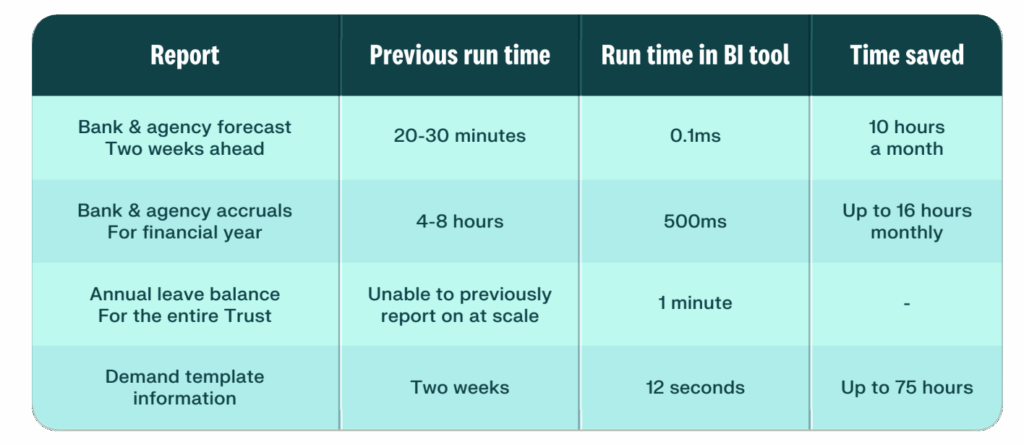Mid and South Essex NHS Foundation Trust powers their decision-making with triangulated workforce data

As one of the biggest NHS Trustsin the UK, Mid and South Essex NHS Foundation Trustserves over 1.2 million peopleevery year. Thecombined organisation provides acute and somecommunity services acrossthree main hospitals.
Manual and time-consuming reporting
Dean Russell, Head of Temporary Staffing at the Trust, had previously been using raw data from the RLDatix Optima rostering system for reporting and analysis, which was challenging due to the sheer amount of data he was dealing with and the time it took to download, export and then upload into their BI tool. For Dean, who regularly needed a clear view of bank and agency data, viewing and analysing week-onweek workforce data was a simple task within RLDatix Optima, but long-term trend analysis over two years or more, was much more time-consuming. The team would need to download 104 separate reports, wait 6 hours each time whilst they downloaded and then manually run queries on them. The Trust wanted to move away from operating according to the ‘feel of things’ and employ a more evidence-based way of working, putting data at the forefront of their decision-making.
Powering their BI with RLDatix DataHub
With a data-first mindset, the Trust decided to start using RLDatix DataHub to feed their workforce data into their business intelligence tool — which immediately empowered them with insights they’d
never had access to before. The Trust is looking at improving planning and oversight within the organisation and one such measure is looking at the distribution of leave across the financial year. But with over 900 cost centres across the Trust and the sheer amount of data, it was something they had never been able to produce before.
Visibility of this information at a local level only meant no one had complete oversight for the entire Trust, which often led to staff building up leave and requesting time off at the same time — resulting in
lots of leave carryover and requirements to fill the shortages with bank or agency staff. This information will be automatically fed into the Trust’s BI tool via RLDatix DataHub, making it available at the touch of a button — which will be a game changer, according to Dean.

The access to up-to-date workforce information via their BI tool has been transformative for Dean and his team. FOI requests are a regular occurrence and the team would spend weeks collating all the information manually. They are now automatically feeding this data directly into a dashboard in their BI tool, allowing them to respond quickly.
Dean has built a dashboard encompassing all regular requests the team receives — so if someone asks him how many off-framework bookings they had last month, he can just click a button and share.
“One of the most powerful things has been theeasy accessto up-to-date data. The ability to pull out what you need really quickly is helping usto makeinformed decisions and dispel myths,” commented Dean.
Feeding workforce data into BI — timesavings

Supporting agency reduction
As part of a wider Trust initiative to reduce agency spend, Dean and his team have set up a dedicated dashboard for clear visibility of when rosters are being sent out, when shifts are being sent to bank and the average time to fill — helping to identify trends in booking behaviours.
By feeding this data into their BI tool, they have been able to triangulate it with demographical data from their ESR. The team can now see who is picking up shifts and why, helping to understand what motivates people and supporting them to fill shifts before going to agency.
The transparency of data gives the Trust confidence in the decisions they are making. The triangulated data means they can easily see and evidence the positive impact their decisions are having on agency spend.
“Publishing rosters six weeks in advance and sending them to bank sooner helps to increase fill rates. This is best practice that all healthcare organisations know. We now have the evidence to back this up and demonstrate it, which has made it so much easier to convince the Trust that priorities need to change and it needs to be about planning ahead. The transparent data is having a big impact, it’s empowering people to change mindsets and behaviours.” Dean Russel, Head of Temporary Staffing, Mid and South Essex NHS Foundation Trust
“It’s not useful to simply see agency use going up and down. What isreally useful is having visibility of behavioural analysis and trends on thingsthat might impact agency usage. Thisis helping usto
understand why it’s going up and down. It’s providing us a layer of transparency we didn’t have before,” said Dean.
Triangulating data
The big benefit for Mid and South Essex has been the triangulation of data. They have started triangulating their workforce data with multiple other sources, such as ESR, vacancy, budget establishment and spend data.
The team now have a connected view of workforce data and vacancies from each cost centre, making it simple to pinpoint areas that are operating outside the vacancy numbers they are established for.
With workforce data automatically available in their BI tool, the Trust can now easily reconcile their demand templates and Finance Standard Rosters (FSRs), showcasing the monthly ESR budget and vacant duties, highlighting any disparities between demand and capacity.
Looking to the Future
In the long term, Dean wants to triangulate workforce and patient activity data, so the Trust can spot trends such as the types of patients coming in and when — and how that impacts sickness, fill rates, bank and agency usage.
From this, they will get a true idea of the driving forces behind bank and agency usage, allowing for better workforce planning. Dean would also like to incorporate machine learning and generative AI reports, helping them to identify things they can’t see from a surface-level analysis. From there, the Trust can build an interventional framework to mitigate risk and introduce positive change.





